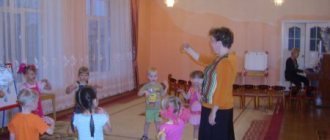Magic box
Summary of a dominant musical lesson for children of the preparatory group using musical
didactic games.
The “Magic Box” music lesson was designed to develop children’s musicality and ability to perceive music emotionally.
Training tasks:
consolidate ideas about the varieties of the dance genre, the rhythmic pattern of the mazurka and polka; to form modal tonal and pitch hearing.
Developmental tasks:
develop emotional responsiveness to musical works, the ability to understand the content and character of musical pieces, creative imagination through musical and rhythmic movements.
Educational tasks:
to cultivate love and interest in classical music and the work of P.I. Tchaikovsky.
Equipment:
piano, music center, flannelgraph.
Demo material:
music Box; “accordion” made of colored paper; Major and Minor dolls, Major and Minor hats; cube with images of musical instruments; snowflakes, fake snowball; diagrams of dance figures.
Handout: "
accordions" made of paper; white chiffon scarves; children's musical instruments.
Progress of the lesson
(Children enter the hall to the “March of the Wooden Soldiers” by P.I. Tchaikovsky, their attention is drawn to the music box.)
Music hands:
Guys, today I discovered this box of riddles.
If we guess them, the box will remain in our garden. There is no way we can do this without your help! Are you willing to help? (Children agree.)
The box is not simple, it is musical!
You, box, open quickly.
Try very, very hard to make it more fun.
Our box is full of secrets and songs,
She will reveal musical secrets to us.
(The teacher opens the box from which music sounds and takes out an “accordion” folded out of paper.)
Music hands:
This harmonica can perform magical transformations depending on the music!
If a polka sounds, it will turn into a skirt, if a mazurka sounds, it will turn into a fan, and if a waltz sounds, it will turn into a butterfly. (The teacher demonstrates the transformations of the “accordion”.)
Let's try it!
(In the musical and didactic game “Accordion-Talker”, children perform these transformations to the sounds of “Children’s Polka” by M.I. Glinka, “Nata Waltz” and “Mazurka” by P.I. Tchaikovsky.) Music
. hands:
Well done! How did you manage to accurately distinguish a mazurka from a polka?
Children:
She has her own rhythmic pattern, not the same as the polka.
Music hands:
Let's clap it to remember it better!
(The game “Repeat the rhythm” is played. Children clap the rhythmic pattern of the mazurka.)
Now let’s clap the rhythmic pattern of the first musical phrase of the polka and lay it out on a flannelgraph.
(Children clap the rhythmic pattern of a polka, and one child lays it out with icons indicating long and short sounds.)
Music. hands:
Is there anything else in the box?
(The teacher takes out the Major and Minor dolls.)
Guys, who is this? What fairy tale are they from?
Children:
These are Major and Minor from "Tales of Music".
Music hands:
Tell me, what is Major’s character?
What does he like? What can you say about Minor? (Children answer questions.)
Today these two musical modes will appear in our lesson.
(The teacher puts the Minor and Major hats on the two children.)
Minor:
Guys, guess which winter fairy tale this snowflake is from?
(Shows a snowflake.)
What dance did she dance with her friends?
Music hands:
A snowball will help Minor answer.
Whoever holds it in his hands will talk about music. (The “Waltz of Snow Flakes” by P.I. Tchaikovsky sounds; children pass the snowball to each other.)
Children:
The music is fabulous, magical, fast-paced, flying, exciting.
Music hands:
Guys, what instrument sounds suit this music?
Look at the cube and choose! (Children look at images of musical and noise instruments on the faces of the cube.)
Children:
A bell, a triangle, and bells are suitable. They have a “cold” sound.
Music hands:
How interesting it is to watch falling snowflakes!
Each performs its own dance, spinning in the air. Let's make a blizzard! Get into the circle quickly and hold hands tightly! You girls will spin around and turn into snowflakes! Hey boys, jump and jump, turn into a breeze! (A musical and didactic game “Convey the character of music with movements” is being held. To the music of P.I. Tchaikovsky “Waltz of Snow Flakes”, girls with scarves improvise a dance of snowflakes, boys imitate the wind; children who have chosen musical instruments play along with them.)
Music. hands:
It turned out to be a wonderful waltz of snow flakes!
Now you will spin around and turn into kids. (The teacher brings a snowflake to his ear.)
Winter comes to us cheerful, cheerful.
Children, the snowflake wants to hear a song. Major will help you guess it. (When performing the game exercise “Recognize the song by your lips,” Major sings without sound, the children guess and call the song “Come, Winter.”)
Music. hands:
Just now a blizzard was swirling here, we depicted it with movements, and now we’ll try to convey the howling of the wind in a voice.
(Children perform a phonopedic exercise.)
Blizzards whistled: “Oooh”
(glissando from bottom to top)
;
snow was flying: “Oh-oh-oh” (glissando from top to bottom)
.
She made the beds with frost: “Ah-ah” (glissando from top to bottom)
.
What is the character of this winter song? (Children answer.)
Try to convey the character of the music in your singing.
(Preschoolers sing the song “Come, Winter!”, music by E. Bolshakova.)
Major:
Now is the time to play in the snow and go sledding!
Music hands:
Let's continue to learn a fun dance!
(The teacher demonstrates diagrams of 3 elements of the 1st dance figure. Children are learning the dance-game “Russian Winter”, music by L. Olifirov.)
Music. hands:
Guys, what is the nature of this music?
Which mode can it be classified as: major or minor? (Children answer this and the following questions.)
Let's remember what types of dance genre do you know?
What dances did we listen to today? Which Russian composer's music did you try to depict with movements? Do you think you succeeded? Guys, you completed all the tasks! The music box remains with us, and it still contains many different secrets. (Surprise moment: Major and Minor give snowflakes to the children.)
Svetlana Kozhedub, music. Supervisor
MBDOU D/s No. 81 “Electronic”, Novorossiysk
The topic of my speech is “Dominant activities”
The topic of my speech is “Dominant activities.”
In the structure of the dominant occupation, one type of musical activity prevails. Used to develop any musical ability and activate the child. If a certain type of musical activity (others, auxiliary) predominates in the dominant lesson, children purposefully master the necessary skills of this particular activity. To develop a lagging ability, it is necessary to group all types of activities around tasks that help improve it.
Let's consider several options for dominant activities.
If the predominant activity in the lesson is the perception of music, all other types of musical activities can be used so that children learn not only to perceive the nature of music, but also to express it with the help of those performing and creative skills that they already possess. Children can convey the character of music in different ways: with movements or, by choosing an expressive timbre of musical instruments that matches the mood of the works, and having orchestrated the piece, perform it on children's musical instruments (accompanied by a piano).
The whole activity is subordinated to one goal - to attract children to the sound of music so that they can express its character in various ways, with the help of other activities.
If singing dominates the lesson, the teacher has the opportunity to concentrate on vocal and choral skills: sound production, breathing, diction, purity of intonation, ensemble, subordinating them to the expressiveness of children's performance. Other activities help children acquire the skills they need in singing. So that the performance of the song is expressive, it is useful to have a conversation about the character and moods that are to be conveyed to the children in its different parts. The technique of comparison with other songs and plays that are contrasting in nature or similar to the song being performed is also appropriate here.
Thus, listening to music and talking about its content alternate with singing.
While singing and during the lesson, the children are offered creative tasks. To understand the nature of sound production and diction, children can use hand movements (smooth or clear) and play musical instruments (drum, pipe).
The lesson will not be static if you include folk games with singing and round dances.
The purity of intonation in singing depends on whether children are aware of the direction of movement of the melody. Therefore, it is recommended to use playing musical instruments, which allows you to simulate the direction of movement of the melody that children will then convey with their voice, as well as musical and didactic games. Thus, listening to music, musical-rhythmic movements and playing musical instruments help improve the quality of singing.
If musical and rhythmic movements dominate, such an activity is also accompanied by listening to music and talking about its character, which the children will have to convey in movements. You can stage and orchestrate round dances with singing, which involve the development of action. The inclusion of musical games (plot-based, non-plot-based) into the lesson makes it entertaining, allows you to improve auditory attention, the ability to timely and expressively convey the change in the nature of music. In such classes, creative tasks and guessing games with elements of pantomime (depictions of animals, etc.) are widely used. Children improvise dance movements and create dances collectively.
Game and competitive techniques allow you to differentiate tasks for the entire group, subgroups, and each child.
With the dominance of playing musical instruments, in addition to teaching children the necessary skills, you can expand their understanding of various musical instruments (folk and instruments, symphony orchestra), and with the help of audio recordings, introduce children to the expressive capabilities of each instrument.
There are also games to guess the timbres of instruments. In such classes, it is appropriate to orchestrate a piece using the expressive timbres of various instruments.
The dominant activity with a predominance of children's musical creativity can include its varieties - song creativity, creativity in musical and rhythmic movements, playing music on musical instruments.
In dominant classes, it is not necessary to involve everything in children’s musical activities, but to select only those that help complete the assigned tasks.
If the dominant activity is devoted to the development of one of the musical abilities and all tasks in various types of activities are aimed at solving this problem, appropriate musical-didactic games and exercises are selected.
Dominant activities may have a specific theme or plot. They are held from 3 to 12 times per quarter.
Example Dominant activity is singing. Electronic presentation.
Get text
Summary of a dominant lesson on listening to music for children 3-4 years old “Who said “Meow?”
Galina OSIPCHUK, music director of the State Educational Institution “Nursery-Garden No. 9, Grodno”
Program objectives: to develop in children the ability to distinguish between noise and musical sounds, to compare and distinguish between high and low sounds; develop musical and auditory perceptions in the process of listening to music, reproduce sounds with the voice easily, melodiously; to cultivate interest in the sound world, goodwill and mutual respect.
Materials and equipment: toys: dog, cockerel, frog, bee, mouse; cups according to the number of children; pieces of paper (according to the number of children); cat hats (according to the number of children); sound recordings: S. Maikapara “In Autumn”, S. Maikapara “Fairy Tale”, Ukrainian folk melody, sounds of nature.
Preliminary work : listening to the works of S. Maykapar.
The phonogram “Sounds of Nature” plays. Children enter the hall freely.
Musical director (hereinafter referred to as M.R.). Guys, what do you hear? (Children's answers).
Yes, we are greeted by the sounds of nature. Are they all the same? (No).
M.R.: No, of course. What sounds do you hear? (Sounds of autumn).
M.R.: Why autumn? (Wind, rain, birds fly to warmer lands). Right.
M.R.: Oh! What do I hear? Have the sounds stopped making noise? And I even know why. Because these sounds are noise. They make noise, like children, sometimes, in a group or on the street.
M.R.: Guys, what other sounds are there? Noise and... (Musical).
Yes, there are noise sounds. Only there are others. Not rustling, not knocking - there are MUSICAL sounds!
M.R.: Absolutely right, all the time in music classes we hear musical sounds. The music is written by the composer. Which composer's plays did we get acquainted with? (Maikapara).
M.R.: Let's try to perform a miracle. We will combine musical and noise sounds. Let's take our noise clouds. To the music of S. Maykapar “In Autumn” we will find ourselves in my favorite fairy tale.
The music of S. Maykapar “In Autumn” is played, the children accompany (paper orchestra).
M.R.: So we flew to visit the dog. How small she is, still just a puppy. Let's say hello to him.
Singing “Hello, Bobik, good dog.”
M.R.: We know a song about him.
The song "Tyav-Tyav!" (music by V. Gerchik, lyrics by Yu. Razumovsky).
M.R.: Now, guys, listen to the story that actually happened to Bobik:
After dinner, our puppy lay down in the corner to sleep. He put his tail under the sofa and hid his wet nose in his paws. (M. Vasilyeva)
M.R.: Our puppy is sleeping, and in his dream he sees a fairy tale. Do you want to be in his dream? And the music of the composer Maykapar, called “Fairy Tale,” will help us. Listen carefully, do not make noise so as not to wake the puppy, move silently, otherwise the fairy tale will end.
Listening – “Fairy Tale” by S. Maikapara (with soap bubbles).
M.R.: Our puppy fell asleep. And at this time...
Suddenly a “meow-meow” sounded very loudly above my ear. Bobik looked under the table and into the cupboard - there was no one in the apartment. The puppy ran into the yard... (M. Vasilyeva)
M.R.: Guys, let’s go outside with the Puppy. (Children walk on their tiptoes to the music and approach the fence on which the Cockerel is sitting.)
M.R.: Guys, look who Bobik met on the street. Who is this? That's right, Cockerel.
Bobik asks the Cockerel: “Did you meow or not? Give me the answer quickly!” And the Rooster said to the Puppy: “I’m singing...” (M. Vasilyeva)
M.R.: Guys, how does the cockerel sing?
Let's all sing loudly together: ku-ka-re-ku!
M.R.: And our Puppy went further. And we will go with him.
The children approach the pond. A fish appears.
Puppy: Was it you, the fish who said: “Meow”?
M.R.: Guys, can a fish say: “Meow”? (No! Pisces don't talk).
M.R.: How come they don’t talk? They open their mouth.
Imitation game "Small and big fish" A frog appears.
Frog: Kwa-ah! Kwa-ah!
Puppy: Did you say “Meow”?
Frog: How stupid you are, Puppy. I just say: “Kwa-a-a!” Kwa-a-a!”
M.R.: Bobik was upset... and suddenly he heard again: “Meow!” And she sat on a flower...
- Who, guys? (Bee).
M.R.: Let's show the puppy how she talks. (W-w-w-w!).
Puppy: Let's run away from here quickly! Now she's going to sting us!
Children walk around the hall to the music and approach the bushes.
M.R.: And again our Bobik heard someone say: “Meow!” The Puppy looked and saw that a small mouse was hiding in the bushes. (Takes out a mouse).
M.R.: Guys, how does the mouse squeak? That's right: pee-pee-pee.
But our Mouse does not live alone, but with her mother. How does the mother mouse squeak?
Game “High-low sounds” (The music director plays one sound in different registers, and the children must say who the voice belongs to).
M.R.: Mice are very nimble animals. They run fast. And they eat the cereal just as quickly. Look, there were grains in these cups recently, but now they are gone. Let's play with them. Let's again combine noise and musical sounds so that our fairy tale does not end.
“Orchestra of Cups” (Ukrainian folk melody)
M.R.: Guys, if a Mouse lives here, then he probably definitely lives nearby... (takes out the Cat).
Puppy : Oh, who is this? (Cat).
M.R.: That's right, Cat. So that's who said: "Meow." Now Bobik knows who woke him up.
That's what she is like. Her paws are soft, she walks silently. And her kittens are playful, cunning, and love to play pranks, like all children. We will now turn into little kittens and hide from our mother cat.
Dance “Grey Cat” (music by V. Vitlin).
The children say goodbye to the Puppy and leave the hall.





